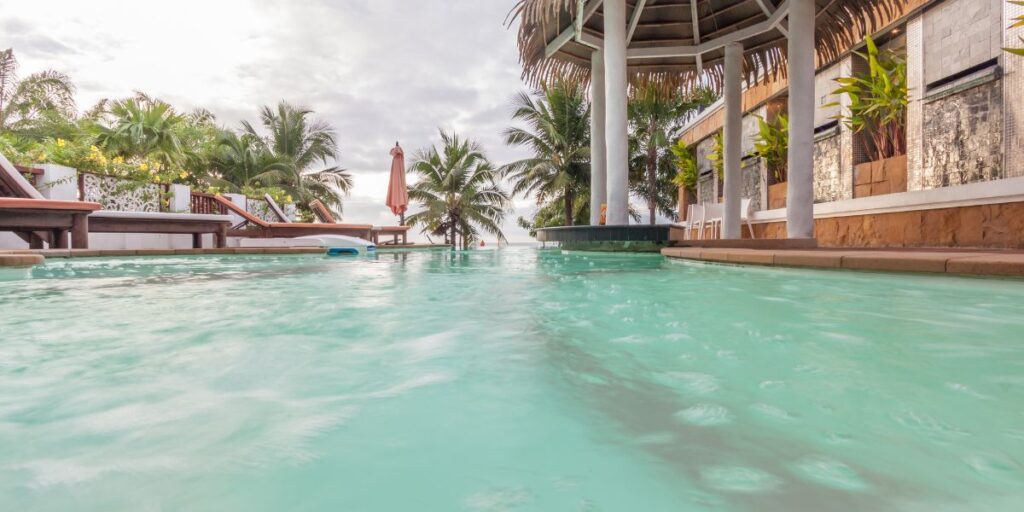Maintaining a clean and safe swimming pool is essential for the health and enjoyment of its users. Chlorination plays a pivotal role in this process by eliminating harmful bacteria, algae, and other contaminants. Understanding the best way to chlorinate your pool can ensure optimal water quality and extend the longevity of your pool infrastructure.
Must Read: How to Use Liquid Chlorine in a Pool
Understanding Chlorine’s Role in Pool Maintenance
Chlorine is a powerful disinfectant that, when added to pool water, forms hypochlorous acid. This compound effectively neutralizes pathogens, preventing waterborne illnesses and keeping the pool water clear. Maintaining appropriate chlorine levels is crucial; insufficient amounts can lead to contamination, while excessive levels may cause skin and eye irritation.
Types of Chlorine for Pool Use

Several forms of chlorine are available for pool sanitation, each with its own advantages and considerations:
- Liquid Chlorine (Sodium Hypochlorite):
- Pros: Quickly raises chlorine levels and is easy to apply.
- Cons: Has a short shelf life and can increase the pool’s pH, necessitating additional balancing.
- Application: Pour directly into the pool water, preferably near the return jets to ensure even distribution.
- Chlorine Tablets (Trichloro-S-Triazinetrione):
- Pros: Slow-dissolving, providing a steady release of chlorine; convenient for regular maintenance.
- Cons: Can lower pH and total alkalinity over time; may increase cyanuric acid levels, which can reduce chlorine effectiveness if too high.
- Application: Place in a floating dispenser, automatic chlorinator, or skimmer basket.
- Granular Chlorine (Calcium Hypochlorite):
- Pros: Effective for shock treatments; rapidly increases chlorine levels.
- Cons: Requires careful handling and pre-dissolving to prevent bleaching of pool surfaces; can raise calcium hardness.
- Application: Pre-dissolve in a bucket of water before evenly distributing around the pool.
- Saltwater Chlorination:
- Pros: Generates chlorine through electrolysis, resulting in softer water and reduced need for manual chlorine addition.
- Cons: Higher initial setup cost; requires maintenance of the salt cell; may be corrosive to certain pool materials.
- Application: Install a saltwater chlorination system that converts dissolved salt into chlorine.
Methods of Chlorine Application
Choosing the right method to introduce chlorine into your pool depends on factors like pool size, usage frequency, and personal preference:
- Floating Dispensers:
- Description: Devices that float on the pool surface, releasing chlorine from tablets over time.
- Pros: Affordable and easy to use.
- Cons: May not distribute chlorine evenly; can get stuck in one area, leading to localized high chlorine concentrations.
- Automatic Chlorinators:
- Description: Installed in-line with the pool’s filtration system, these devices regulate chlorine release automatically.
- Pros: Provides consistent chlorine levels; reduces manual handling.
- Cons: Higher upfront cost; requires professional installation and periodic maintenance.
- Manual Addition:
- Description: Directly adding liquid or granular chlorine to the pool water.
- Pros: Allows for immediate adjustment of chlorine levels.
- Cons: Requires frequent testing and manual dosing; risk of uneven distribution if not done properly.
Best Way to Chlorinate a Pool
To ensure optimal chlorination and maintain a healthy pool environment, consider the following practices:
- Regular Testing:
- Test chlorine levels at least twice a week using reliable test kits or digital testers.
- Maintain free chlorine levels between 1-3 ppm for safe swimming conditions.
- Balancing Pool Chemistry:
- Keep pH levels between 7.2 and 7.6 to maximize chlorine efficacy.
- Monitor and adjust total alkalinity and calcium hardness to prevent scaling or corrosion.
- Shock Treatments:
- Perform weekly shock treatments, especially after heavy pool usage or rainfall, to eliminate combined chlorine compounds (chloramines) and organic contaminants.
- Proper Storage and Handling:
- Store chlorine products in a cool, dry place away from direct sunlight.
- Use appropriate protective gear, such as gloves and goggles, when handling chlorine to prevent skin and eye irritation.
- Avoid Mixing Different Chlorine Types:
- Never mix different forms of chlorine, as this can lead to dangerous chemical reactions.
- Use separate equipment for each type to prevent cross-contamination.
Alternative Sanitization Methods
While chlorine is the most common pool sanitizer, alternative methods are available:
- Bromine:
- Pros: Effective in a wider pH range; produces fewer odors; more stable in warmer water.
- Cons: More expensive than chlorine; can be less effective under direct sunlight without stabilizers.
- Ozone Generators:
- Pros: Powerful oxidizer; reduces the need for high chlorine levels; leaves no chemical residues.
- Cons: Does not provide a residual sanitizer; requires supplemental chlorine or bromine; higher initial cost.
- UV Systems:
- Pros: Destroys microorganisms effectively; reduces chemical usage; environmentally friendly.
- Cons: No residual sanitization; requires additional sanitizers; periodic lamp replacement needed.
Conclusion
Effective chlorination is fundamental to maintaining a safe and inviting swimming pool. By understanding the various types of chlorine, application methods, and best practices, pool owners can ensure their water remains clean and healthy. Regular testing, proper chemical balancing, and adherence to safety guidelines will contribute to a pleasant swimming experience for all users. For professional assistance in pool maintenance or to explore custom pool solutions, consider reaching out to Cutters Pools, a trusted pool builder in Austin, Texas



